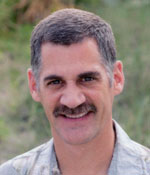
During one particular two-verses-two air combat tactics training mission in an F-15, I was maneuvering to engage another aircraft. From a slightly nose-low right-hand turn, I banked left to about 45 degrees of bank, lit the afterburners, neutralized the ailerons, and then pulled back hard on the stick to start a climb, pulling about 5 to 6 Gs. I was looking up at clear blue sky and the other airplane that I was trying to engage. As my nose came up through the horizon, the airplane did an uncontrolled snap roll to the right into an inverted position. Because it happened so fast and because I was still pulling back on the stick, I wound up about 40 degrees nose low, inverted, looking at a whole lot of brown Earth in my windscreen and canopy as I accelerated downward.
 This rapid sequence of events really startled me. The good news was that I was quite used to being pointed in all different directions in an airplane, so recovery was just a matter of neutralizing the controls, retarding the power, rolling upright, and then pulling the nose back to level flight. This may sound simple, but without the proper training it could have gone a lot worse. This is such an important skill for Air Force pilots that during Air Force pilot training, students are exposed to instrument and visual unusual attitude training in the simulator before they even take their first flight in an airplane. In addition, throughout the course of the yearlong training, these skills are reinforced in the airplane.
This rapid sequence of events really startled me. The good news was that I was quite used to being pointed in all different directions in an airplane, so recovery was just a matter of neutralizing the controls, retarding the power, rolling upright, and then pulling the nose back to level flight. This may sound simple, but without the proper training it could have gone a lot worse. This is such an important skill for Air Force pilots that during Air Force pilot training, students are exposed to instrument and visual unusual attitude training in the simulator before they even take their first flight in an airplane. In addition, throughout the course of the yearlong training, these skills are reinforced in the airplane.
Even though most of us are flying general aviation aircraft in the normal category, where bank angle is limited to 60 degrees, that does not mean you won’t get in a situation requiring recovery from an unintended flight attitude. In addition, we are all well aware of the dangers of VFR flight into instrument meteorological conditions, where unusual attitudes often develop. So, my question to you is this: Are you prepared to recover from an unexpected inflight attitude, including maybe wings level, inverted, 40-degrees nose low, possibly in the weather?
We are all required to do a flight review to maintain currency, and the flight maneuvers are largely left to your choice. I would suggest everyone—even the VFR-only pilots—include some simulated or actual instrument time and instrument unusual attitude recovery training on your next flight review. Then to really make you a better, well-rounded pilot, and add some fun to your flying repertoire: Find an instructor with an airplane that can do upset recovery training. Learn the proper procedures to recover from an unexpected nose-high or nose-low situation. It may save your life, and you might have some fun in the process.
Larry Brown of Colorado Springs, Colo., is a retired Air Force F-15 pilot who is using the lessons he learned as a fighter pilot as a GA pilot in his Cessna P210. Brown, who has 2,600 hours total time during his 32 years of flying, also was an instructor pilot and flight examiner in the Air Force T-38 and instructor pilot in the T-52, the military’s version of GA’s Diamond DA40. See previous installments in the Fly like a fighter archive.



